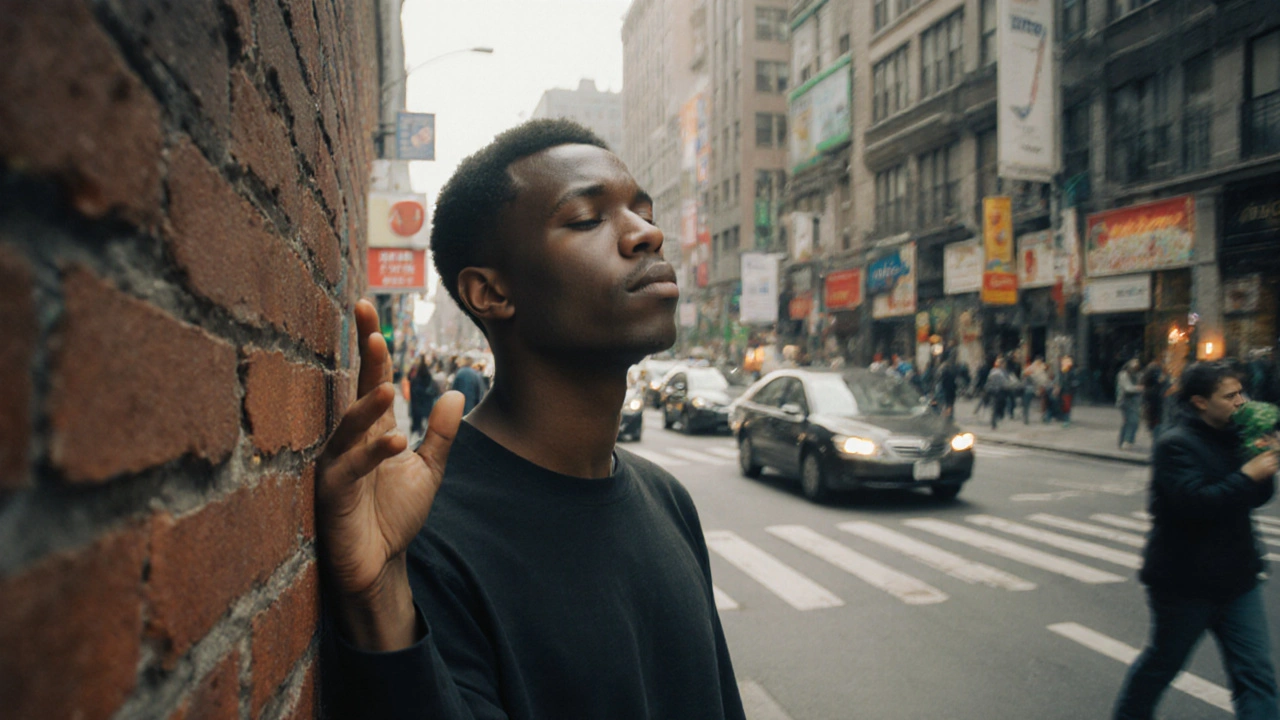
Stress Relief Quick Guide
Your Stress Signals
Select the symptoms you're feeling right now:
Most people think stress is something you just have to live with. That’s not true. Stress isn’t a permanent state-it’s a signal. Your body is telling you something’s out of balance. And the good news? You can reset it. Not with expensive apps, supplements, or weekend retreats. But with simple, daily habits that actually stick.
What mindfulness really means (and what it doesn’t)
Mindfulness isn’t sitting cross-legged for an hour chanting. It’s not about emptying your mind. It’s about noticing what’s happening right now-without judging it. When you’re stuck in traffic and your heart starts racing, mindfulness is noticing the tightness in your chest, the speed of your breath, and then letting it be there. No need to fix it. No need to fight it.
That’s the shift. Most stress reduction techniques try to push stress away. Mindfulness says: let it be, but don’t let it run the show. Studies from the University of Massachusetts show that people who practiced mindfulness for just eight weeks reduced their cortisol levels by 25%. That’s not magic. That’s biology responding to consistent awareness.
Your body knows when you’re stressed-before your mind does
Think about the last time you felt overwhelmed. Did you notice your shoulders creeping up to your ears? Your jaw clenched? Your stomach tight? These aren’t just feelings. They’re physical signals. Your nervous system is stuck in fight-or-flight mode.
Here’s what most people miss: you don’t need to meditate to calm your nervous system. You just need to interrupt the cycle. Try this next time you feel tension rising: place both hands on your belly. Breathe in slowly through your nose for four counts. Hold for two. Exhale through your mouth for six. Do this three times. That’s it. You’ve activated your parasympathetic nervous system-the one that says, “We’re safe now.”
This isn’t theory. It’s how your body works. Deep, slow breathing triggers the vagus nerve, which slows your heart rate and lowers blood pressure. No app needed. No subscription. Just your breath.
Three tiny habits that cut stress in half (no willpower required)
You don’t need to overhaul your life. Small, repeatable actions build real change.
- Start your day with one minute of stillness. Before you check your phone, sit on the edge of your bed. Feel your feet on the floor. Notice the air entering your nostrils. That’s it. One minute. This sets a tone of calm instead of chaos.
- Pause before reacting. When someone says something that triggers you, count to three before responding. Not to be polite. To break the automatic stress-response loop. Most arguments happen because we react before we think. That pause gives your prefrontal cortex-a.k.a. your rational brain-a chance to catch up.
- End your day with a 5-minute mental dump. Keep a notebook by your bed. Write down everything buzzing in your head: tasks, worries, random thoughts. Don’t edit. Don’t organize. Just get it out. This clears mental clutter so your brain can rest. People who do this regularly report better sleep and fewer morning anxiety spikes.
These aren’t grand gestures. They’re micro-habits. But over time, they rewire how your brain handles pressure.

Why trying to “relax” makes stress worse
Have you ever told yourself, “I need to relax,” and then felt even more stressed because you couldn’t? That’s because “relax” is a goal, not a method. You can’t force relaxation. It’s a byproduct of letting go.
Think of it like trying to fall asleep. The harder you try, the more awake you become. The same goes for calm. Instead of chasing relaxation, focus on presence. What can you feel right now? The texture of your shirt? The sound of the wind outside? The weight of your body in the chair?
When you anchor yourself in sensory details, you pull your mind out of the future (what’s coming) and the past (what went wrong). That’s where stress lives. Not in the present moment.
What to do when stress hits hard-right now
Sometimes, stress doesn’t whisper. It screams. You’re in a meeting, your chest feels tight, your hands are shaking. What do you do?
Here’s a quick reset: the 5-4-3-2-1 technique.
- Look around and name 5 things you can see.
- Touch four things and name what they feel like-fabric, metal, wood, air.
- Listen for 3 sounds-a fan, distant traffic, your own breath.
- Identify 2 smells-coffee, soap, rain.
- And one thing you can taste-your lips, gum, water.
This isn’t a trick. It’s neuroscience. When you engage your senses, you force your brain to switch from panic mode to observation mode. Your amygdala (the fear center) calms down. Your prefrontal cortex comes back online. You regain control.

How to make mindfulness stick (without feeling guilty)
The biggest reason people quit mindfulness? They think they’re doing it wrong. You’re not supposed to feel peaceful every time. Some days, your mind will race. That’s normal. The practice isn’t about having a quiet mind. It’s about noticing when it’s loud-and gently bringing it back.
Try this: link mindfulness to something you already do. Brush your teeth? Feel the bristles on your gums. Walk to the mailbox? Notice the rhythm of your steps. Drink your coffee? Taste it. Don’t rush. That’s mindfulness. No extra time needed.
And if you miss a day? Don’t beat yourself up. Missed a day? That’s life. Just start again. Consistency beats perfection every time.
What blocks mindfulness-and how to clear it
Two things get in the way: judgment and expectation.
Judgment: “I’m bad at this.” “I’m too distracted.” That’s your inner critic talking. Mindfulness isn’t about being good at it. It’s about noticing the critic-and letting it sit there without listening.
Expectation: “I should feel calmer after this.” That’s the trap. You’re trying to achieve a result, not experience the process. Let go of the outcome. Just show up.
Think of it like watering a plant. You don’t check every hour to see if it’s grown. You water it, and trust the process. Mindfulness works the same way.
Your stress isn’t your enemy
Stress isn’t the problem. It’s your relationship with it. You can’t eliminate stress. Life will always throw things at you. But you can change how you respond.
Mindfulness doesn’t make life easier. It makes you stronger in it. You stop running from discomfort. You stop fighting your own thoughts. You learn to sit with what’s hard-and still choose how to act.
That’s the real power. Not peace all the time. But resilience when things get loud.
Can mindfulness replace therapy for stress?
Mindfulness is a powerful tool, but it’s not a substitute for professional help when stress becomes chronic, overwhelming, or linked to anxiety or depression. Therapy addresses root causes, trauma, or chemical imbalances that mindfulness alone can’t resolve. Think of mindfulness as a daily maintenance tool-like brushing your teeth. Therapy is like seeing a dentist when something’s seriously wrong. They work best together.
How long until I notice a difference?
Some people feel calmer after just a few days of consistent practice, especially with breathing or sensory grounding. But real, lasting change usually shows up after 4-6 weeks. That’s when your brain starts forming new neural pathways. Don’t wait for a big shift. Look for small signs: fewer reactive moments, better sleep, less jaw clenching. Those are the wins.
Do I need an app or guided meditation?
No. Apps can help at first, especially if you’re new. But real mindfulness happens in real life-while washing dishes, walking, or waiting in line. The goal is to become your own guide. Once you understand the basics, you can practice anywhere, anytime, without any tech. In fact, relying too much on apps can make you dependent instead of self-reliant.
What if I don’t have time for mindfulness?
You don’t need more time. You need to use the time you already have differently. Mindfulness isn’t something you add to your day. It’s how you do the things you already do. Brush your teeth mindfully. Walk to your car mindfully. Wait for your coffee mindfully. Those moments add up. Five minutes of real presence is better than 30 minutes of distracted “practice.”
Can children or older adults practice mindfulness?
Absolutely. Mindfulness works at any age. Kids benefit from simple sensory games-like noticing sounds or textures. Older adults often find it helps with loneliness, pain, or racing thoughts. The key is adapting the practice. A 7-year-old might do a “breathing buddy” exercise with a stuffed animal. A 70-year-old might focus on the feeling of their feet on the floor while sitting. It’s not about how you do it. It’s that you do it.
If you want to feel less pulled apart by daily pressure, start small. One breath. One pause. One moment of noticing. That’s where calm begins-not in some distant future, but right now, in the space between your thoughts.





